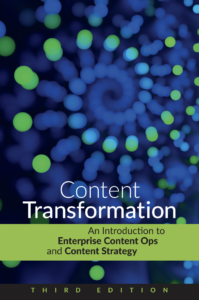The challenge of digital transformation
Digital transformation touches on every aspect of business operations. At Scriptorium, our focus is on high-value content, so our definition of digital transformation is also content-centric:
“Digital transformation is the use of technology to enrich information delivery.”
“Enriched” information is usually divided into two major categories:
- Content delivery
- Context
Content delivery
Books are often cited as the flat “before” example of technology, but even in the analog world, you can provide rich information. Consider the difference between basic text, a pop-up book, and an audiobook.
In the digital world, we have many options, such as text, graphics, and sound; or video, which combines all three. Other possibilities include Braille and haptic feedback (for example, when you touch a phone screen and get a vibration).
Even within a single delivery type, such as text, you have numerous possibilities—font and other formatting choices or a variety of delivery mechanisms (PDF, HTML, and others).
To ensure accessibility of your content, you need to convey information in multiple ways. For example, a podcast should have a transcript. For someone with a hearing impairment, a transcript provides an alternative to the audio track. In addition, providing choices means that you will reach a broader audience—some people just don’t like listening to podcasts, but will read a transcript.
Context
To add context to information, you need knowledge about the content consumer’s circumstances, such as:
- Location: in a factory, a content portal could display information for the machine the user is closest to
- Customer profile: a content portal can display only information about the products that the customer has purchased
- Device: Information is displayed differently on a phone, a laptop screen, and an e-reader
- Preferences: Once the consumer expresses a preference for video over text, for larger text, or for a specific language that preference should persist
There are of course many other context possibilities.
Prerequisites for content delivery and context
To deliver on the promise of contextually relevant content, you need structured content. Content is structured when you can define and enforce required components. In addition, you need labels, such as target audience or a specific product version. Structured content describes itself via component names and labels (metadata). It does not include formatting information. If you have structured content, you can use information about the user to filter, rearrange, and format content to meet that user’s needs.
Weather forecasts are a favorite example of contextual information. A phone app can pinpoint weather information based on the phone’s location. (And further, it can show weather warnings exactly when and where needed.) In industrial contexts, knowing a worker’s location is helpful to generate work orders, provide relevant technical information about nearby equipment, and so on. Location context is powerful—and must be used with care.
But location alone isn’t enough. The user’s location must be paired with contextually aware content. So you have to connect the context (worker is at location X in factory 4) with additional information (machines 1, 2, and 3 are nearby) and then have the ability to retrieve relevant information (content for machines 1, 2, and 3). To achieve this goal, you must label relevant content with metadata that identifies the machine number and provide a factory grid that maps out the location of all of the machines.
Toward digital transformation
As we begin to explore the potential of digital content, we need to pay attention to several key factors:
- How can we customize information based on context?
- How can we manage the information flow to avoid overload?
- How much control do we give to the consumer?
- How much control do we give to the content delivery system?
- What are the ethical implications of contextual content?
- What are the costs and benefits of contextual content?
Structured content is often promoted as a way to reduce content development costs with automated formatting. But automation may be the least important feature that structured content offers. Structured content provides a way to label content, makes it easier to trace content throughout the content lifecycle, and is machine-consumable. It is those factors that make digital transformation a reality for content.
Are you looking for support in digital transformation of your high-value content? Read our white paper on Scriptorium’s approach to content strategy or contact us to get the conversation started.


